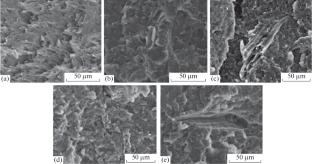Novel Biocomposites Based on El Retma Natural Fiber and PLA/PC Mixture Compatibilized Using Samarium Acetylacetonate Catalyzed Interchange Reactions
Abstract—
In this work, the properties of biocomposites based on poly(lactic acid)/polycarbonate (PLA/PC) mixture and a flour obtained from a local plant which is El Retma (RET) are investigated. Due to the incompatibility of PLA/PC matrix, a transesterification catalyst which is samarium acetylacetonate (Sm) is added to promote interchange reactions and synthesize PLA-PC copolymer at the interface between the polymers. Furthermore, to improve adhesion of the natural fiber to the matrix, RET flour has been pretreated using an alkaline solution before treatment with maleic anhydride (MA). Also, to point out the effect of the rate of MA grafting and RET flour size, the properties of biocomposites based on MA-RET flours with flour sizes below 100 and 50 µm are compared. The composites with mixing time varying from 10 and 20 min have also been studied because they are expected to present different performances due to the different extents of catalyzed transesterification reactions. Fourier transform infrared spectroscopy (FTIR) and thermogravimetric analysis attested for the grafting of maleic anhydride grafting after the observation of carbonyl group band in FTIR spectra of MA-RET flour and the improvement of its thermal stability compared to the pretreated flour. The composite PLA/PC/Sm/MA-RET melt mixed during 20 min revealed better impact resistance, thermal stability and storage modulus due to the eventual higher concentration of PLA-PC copolymer and grafting of PLA and PC chains on the flour.


 求助内容:
求助内容: 应助结果提醒方式:
应助结果提醒方式:


